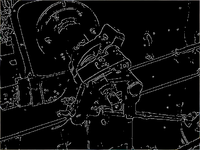
Photo from wikipedia
Vision-based defect-detection systems are currently being applied to many manufacturing processes and have contributed to factory automation and production of highquality goods through the development of image-analysis techniques. There are… Click to show full abstract
Vision-based defect-detection systems are currently being applied to many manufacturing processes and have contributed to factory automation and production of highquality goods through the development of image-analysis techniques. There are many image-analysis techniques used in surface defect detection such as statistical-, filter-, and model-based approaches.1) Among them, filter-based approach is highly advantageous for spatial-frequency analysis, which is more useful on surfaces with noisy and variations in intensity.2) Further, some of these approaches analyze the statistics and structure of a defect after filtering to improve the reliability of the defect-detection process. The general process of a filter-based approach is shown in Fig. 1. First, images are preprocessed, e.g., through segmentation to find regions of interest (ROIs), or undergo a smoothing process to eliminate noises, depending on the particular application. After preprocessing, the images are An Adaptive Selection of Filter Parameters: Defect Detection in Steel Image Using Wavelet Reconstruction Method
Journal Title: Isij International
Year Published: 2020
Link to full text (if available)
Share on Social Media: Sign Up to like & get
recommendations!